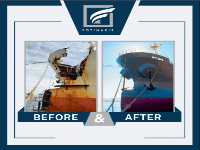Tonnage tsunami: can ports withstand the ULC surge?
CONTAINER port congestion — already a recurring headache — could soon become a whole lot worse.
The Ever Given (IMO: 9811000) incident may have thrust global shipping inefficiencies into the public spotlight, but it was just one in a series of black swan events it preceded, whether the pandemic, the Red Sea crisis or Russia’s invasion of Ukraine, that laid bare deep-rooted vulnerabilities in the global supply chain. Now, with a new wave of ultra-large containerships poised to hit the water — the weapon of choice for big carriers on mainline trades — ports face a looming crisis.
Vessel upsizing and cascading are familiar challenges, but the sheer volume of fresh ULC tonnage threatens to overwhelm port infrastructure and strain global supply chains like never before.
Indeed, major carriers have poured billions into fleet expansion, with many newbuildings designed for alternative fuels and tighter emissions standards.
Shipyards in China and South Korea, backed by state financing, have eagerly secured orders for high-margin ULCs. Flush with post-2021 profits and strong credit ratings, container lines have obliged — fuelling orderbooks that now stretch to 2029.
According to Alphaliner, the backlog of orders for new containerships has reached record levels and is now far in excess of 10m teu, representing some 31.1% of the fleet capacity in service.
With growth in global container demand expected to be muted at best through to the end of the decade, many, and rightly so, have pointed to the overcapacity bloodbath that lies in wait.
Only time will tell just how profound the impact of this tonnage deluge will be on freight markets. To compensate carriers will almost certainly look to accelerate the scrapping of vessels deemed surplus to requirements or entering their twilight years. However, only so many ships can be sent to the beaches for scrap, with cash buyers already concerned over the prospect of recycling capacity constraints.
What is also important however is the composition of newbuildings. The large majority fall into the category of ULCS, or 14,000+ teu ships, and a significant number up and above 18,000 teu. Indeed, the latest newbuilding figures from Alphaliner show there are as many vessels under construction as there are in operational fleet, with as many as 170 units due off the ramps in the next five years alone.
To make way, carriers will likely revert to their tried-and-tested strategy of redeploying tonnage to secondary and intermediary trades — in reality, their only viable option.
Fundamentally, key ports serving the trunk trades, most notably Asia-Europe, have been purpose-built and upgraded to accommodate ultra-large vessels. Yet the sheer volume of new ships entering service will trigger a tipping point. It’s not just the rollout of 18,000+ teu or even 23,000+ teu, but the cascading displacement of 14,000+ teu ships that must be reassigned to other trades to clear space.
Lloyd’s List recently noted how West Africa is emerging as an unlikely destination for Mediterranean Shipping Co’s 23,000 teu giants, thanks to a handful of transhipment terminals tailored to their scale. But such facilities are rare, and global port capacity to absorb this wave of ULC tonnage remains severely limited.
Scale without synchrony
ULCs promise economies of scale at sea, but they have exposed inefficiencies ashore. The post-pandemic surge in trade revealed how many ports lacked the labour and infrastructure — dockworkers, truckers and cranes — to handle the volume of cargo lifted off these industry titans in one fell swoop. Longer berthing times, expanded storage needs, and service unreliability turned scale into strain.
Eleanor Hadland, ports and terminals senior analyst at Drewry, highlighted a critical disconnect between theoretical terminal capacity and operational reality. While port infrastructure may appear adequate on paper, the rise of ULCs has revealed a mismatch between ship design and port functionality.
Terminals originally built for steady flows of mid-sized vessels are increasingly faced with erratic arrivals and missed berthing windows, disrupting yard planning and landside logistics.
“Before the pandemic, there was far greater emphasis on fixed weekly and daily schedules. Carriers are now making far more use of blank sailings, so there’s far more intermittency and volatility,” she told Lloyd’s List.
This volatility undermines reliability, and when vessels miss their berthing windows, the pressure cascades across the supply chain. Even highly developed ports such as Shanghai — designed to handle multiple ULCs simultaneously — struggle when ships miss their slots. Cargo piles up, yard space tightens and queues build rapidly. This cascading pressure is now mirrored across ports worldwide.
Yet, Hadland argues, this stress is often misattributed to terminal inefficiency.
ULCs may generate economies of scale, but they place far more stress on the rest of the supply chain, she explained. “It just so happens that ports are where you see it. People say, ‘the yard is full, the congestion is bad, the waiting time is long’. But no one says, ‘there aren’t enough trucks’ or ‘rail capacity is lacking’.”
While adding more trains or trucks could be part of the solution, Hadland noted that such conversations are rarely prioritised. Instead, the blame tends to fall squarely on terminal operators.
In Europe, where trade growth remains modest, infrastructure investment tends to be cautious and incremental — favouring slow, cashflow-funded yard conversions over rapid upgrades or speculative terminal expansions. Whereas in China, robust trade growth and high utilisation levels continue to justify large-scale port development, highlighting stark regional contrasts in how ports are adjusting to the era of ULCs, explained Hadland.
Tiemen Meester, group chief operating officer of DP World’s Ports & Terminals division, emphasised that while the rise of ULCs was anticipated, the industry underestimated how quickly ports could adapt.
“You see workhorse-sized vessels, let’s say between 12,000 and 18,000 teu, cascading into the sub and north/south trades definitely accelerating. For the first time, you see very large ships on the west coast of Africa that would be unthinkable a decade ago,” said Meester.
Common-user terminals — those not controlled by shipping lines, such as in the case of DP World — face particular challenges in scaling up height, reach and depth, as they lack the agility to accelerate investments. Meester warned that deploying larger ships comes with significant capital costs and requires a clear business rationale, which often lags behind operational needs. As a result, the number of terminals capable of handling these vessels has “proportionally reduced”.
Igor van den Essen, APM Terminals’ chief executive for Africa and Europe, added that schedule reliability is a critical factor in managing congestion. Larger vessels don’t necessarily mean more cargo per port call, but when arrivals are unpredictable, it disrupts resource planning and landside logistics. He pointed to the ripple effects of events such as the Suez Canal disruption, which forced vessels into ports not designed for their size, compounding delays.
In regions like Africa, the problem is often external to the terminal itself, van den Essen added. Ports such as Abidjan and Lagos suffer from inadequate infrastructure beyond the gate, with trucks waiting days to access terminals. Rail solutions are being explored, but progress is slow.
Meanwhile, in Europe, legacy port locations like Genoa face geographic constraints that limit expansion, making it difficult to reconfigure the existing ecosystem. Van den Essen stressed that overcoming these challenges demands integrated logistics and tighter supply chain coordination.
Shipping economist Martin Stopford offers a sobering assessment of ULCs, arguing their operational inefficiencies — particularly excessive time spent in port — have undermined their productivity. Despite continued orders, he believes the upward trend in vessel size has peaked and failed to deliver on its promise.
Stopford warned that geopolitical shifts, too, are pushing cargo into smaller and medium-sized ports that lack the infrastructure to cope with surging volumes. These changes are not accompanied by large-scale, high-profile investments, but rather piecemeal adjustments — often without sufficient funding.
Instead of building even bigger ports, Stopford advocated for a regional distribution model.
“In other words, you do what McKinsey always said you were supposed to do with containerisation,” said Stopford.
“You have some very big distribution centres like Rotterdam, for example, you stick all the containers from Mexico or Malaysia, or wherever it is, on to a small ship and take it to the final destination, which might be somewhere like Aberdeen or Newcastle, or anywhere in Northwest Europe.”
This approach, he estimated, could reduce carbon emissions by 40%-60% without requiring fully green ships — offering both environmental and operational benefits.
Still, he acknowledged that carriers are now locked into a ULC future.
What this future looks like will depend on how the industry responds to the challenge of accommodating larger vessels, and how successful they become in developing more adaptive port ecosystems capable of managing scale efficiently.
If these adjustments fall short, localised congestion may become routine as vessel queues grow. With supply chains already strained, another disruptive event — geopolitical, environmental, or economic — could swiftly push ports from disruption to paralysis.
Content Original Link:
" target="_blank">





















































